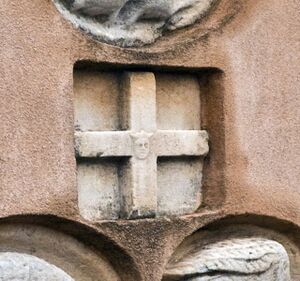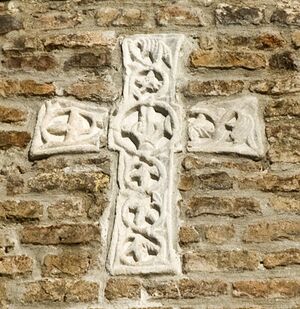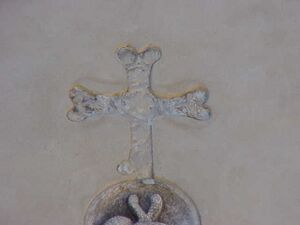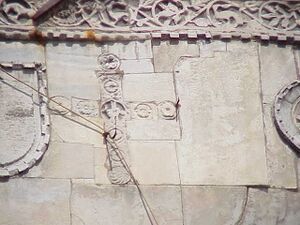Cross: Difference between revisions
Created page with "''This page contains information about a typical Venetian cross.'' {{for|a list of crosses|Crosses}} ==Types== right|thumb|Greek cross [[Ima..." |
Pierotoffolo (talk | contribs) No edit summary |
||
| (2 intermediate revisions by one other user not shown) | |||
| Line 2: | Line 2: | ||
==Types== | ==Types== | ||
[[Image:figure3_greekcross.jpg|right|thumb| | [[Image:figure3_greekcross.jpg|left|thumb|Greek cross]] | ||
[[Image:figure3_cross2.jpg|right|thumb|Latin cross]] | |||
[[Image:CN365.jpg|left|thumb|Maltese cross]] | [[Image:CN365.jpg|left|thumb|Maltese cross]] | ||
Venetian crosses can be categorized into four main types: | [[Image:CN386.jpeg|lright|thumb|Byzantine cross]] | ||
Venetian crosses can be categorized into four main types: greek, Latin, Byzantine, and Maltese. | |||
===Greek=== | ===Greek=== | ||
Greek crosses, or ''crux immissa quadrata'', are the most simple and plain in nature. Typical Greek crosses have arms of equal length that intersect toward the center of the vertical beam. Because of this, Greek crosses tend to appear square in nature. | Greek crosses, or ''crux immissa quadrata'', are the most simple and plain in nature. Typical Greek crosses have arms of equal length that intersect toward the center of the vertical beam. Because of this, Greek crosses tend to appear square in nature. | ||
| Line 37: | Line 38: | ||
[[Category:Crosses]] | [[Category:Crosses]] | ||
[[Category:Public | [[Category:Decorative Artifacts]] | ||
[[Category:Public Art]] | |||
Latest revision as of 16:37, 31 August 2015
This page contains information about a typical Venetian cross.
Types




Venetian crosses can be categorized into four main types: greek, Latin, Byzantine, and Maltese.
Greek
Greek crosses, or crux immissa quadrata, are the most simple and plain in nature. Typical Greek crosses have arms of equal length that intersect toward the center of the vertical beam. Because of this, Greek crosses tend to appear square in nature.
Latin
Unlike Greek crosses, Latin crosses tend to have ornate decoration. Much of this decoration exists as detailed carvings representing geometric or floral patterns. The arms of Latin crosses also differ from Greek crosses, with the horizontal beam intersecting the vertical beam closer to the top. This Latin style is the most common and recognizable style of cross.
Byzantine
Byzantine crosses are very similar to Latin crosses apart from one main difference: Byzantine crosses contain a second (smaller) horizontal beam above the main one. Byzantine crosses are commonly referred to as Patriarchal crosses.
Maltese
Maltese crosses tend to be the most distinguishable cross style. Unlike Greek and Latin crosses, the arms of Maltese crosses taper as they move inward. In addition the ends of each of the arms are indented, giving the Maltese cross a distinct look. However, like Greek crosses, Maltese crosses have arms of equal length that intersect toward the center giving them a square appearance. Much like confraternity symbols and coats of arms, Maltese crosses were often used to indicate ownership of a building.
See Also
| ||||||||||||||||||||
References
NULL
Bibliography
- 2010 WPI PreserVenice Project Team
- 2008 WPI PreserVenice Project Team
- 2007 WPI PreserVenice Project Team
- 2000 WPI PreserVenice Project Team